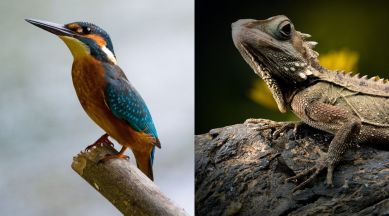Chicken before the egg: Early birds, reptiles may have given birth to young, study suggests
A new study suggests that the earliest reptiles and birds carried their young within their bodies for extended period of time.

The question of which came first, the chicken or the egg is an eternal one. Based on a new study, it would be a good idea to bet on the chicken, because it suggests that the earliest reptiles and birds may have borne their young, according to the University of Bristol.
Scientists believed that hard-shelled eggs were the key to the success of amniotes. They are a group of vertebrates whose foetuses develop inside an amnion, or a protective membrane inside the egg.
monthly limit of free stories.
with an Express account.
But a study of 51 fossil species and 29 living species published in the journal Nature Ecology and Evolution suggests otherwise. The study shows that all the great branches of Amniota, including Mammalia (mammals), Lepidosauria (lizards and other reptiles) and Archosauria (dinosaurs, crocodiles, and well, birds) seemed to be viviparous and show signs of retaining embryos within their bodies of extended periods of times.
Viviparous animals are those that directly give birth to their young. Oviparous animals, on the other hand, do not give birth to their young. Instead, they lay eggs that are either fertilised or unfertilised.
Extended embryo retention (EER) refers to when the young are retained by their mothers for a varying amount of time, depending on if the conditions are ideal for survival or not.
For a long time, scientists have considered hard-shelled eggs as one of the greatest innovations in evolution but this new research implies that extended embryo retention is what gave this group of animals the ultimate protection.
“Before the amniotes, the first tetrapods to evolve limbs from fishy fins were broadly amphibious in habits. They had to live in or near water to feed and breed, as in modern amphibians such as frogs and salamanders,” Michael Benton from the Bristol’s School of Earth Sciences explained in a press statement. Benton is a co-author of the research article.
According to Benton, when amniotes appeared around 320 million years ago, they were able to break away from the water by evolving waterproof skins and other characteristics that allowed them to control water loss. But the amniotic egg was key here. In a way, the amniotic was thought to be a “private pond” in which a developing reptile was protected from drying out in warm climates. This was believed to be what allowed Amniota to move away from waterbodies and dominate the land.
“This standard view has been challenged. Biologists had noticed many lizards and snakes display flexible reproductive strategy across oviparity and viviparity. Sometimes, closely related species show both behaviours, and it turns out that live-bearing lizards can flip back to laying eggs much more easily than had been assumed” said Baoyu Jiang, leader of the project, in a press statement. Jiang is a professor at Nanjing University.
According to Armin Esler, co-author of the study, when the researchers looked at fossils, they found that many ancient marine reptiles were live-bearers. Some other fossils showed the to-and-fro between oviparity and viviparity, not just lizards.
EER, where the mother keeps the developing young within their body, is quite common among vertebrates today. It is also quite widespread and variable in lizards and snakes. These animals can release the young, either inside an egg or as little wrigglers, during different stages of their development. EER could present an advantage when mothers are able to release their young when temperatures are warm and there are enough food supplies.
Benton concludes that the new study, along with others in recent years “consigns the classic ‘reptile egg’ model of the textbooks to the wastebasket. This could mean that amniotes evolved EER instead of a hard-egged shell to protect their developing embryo.